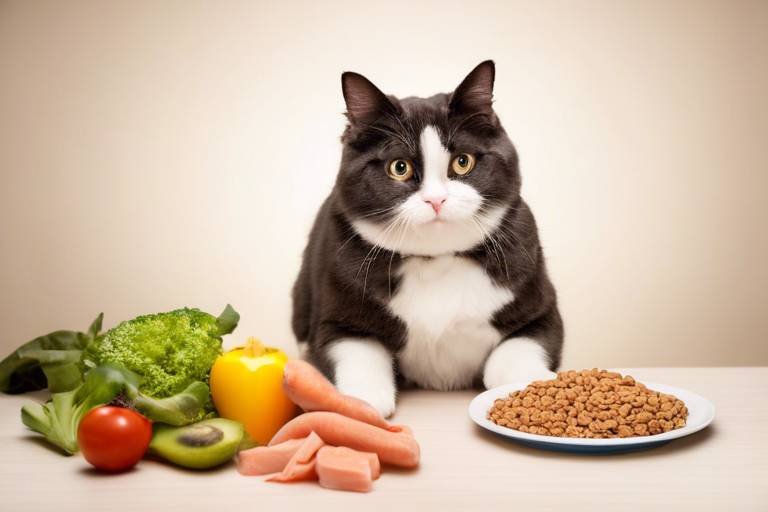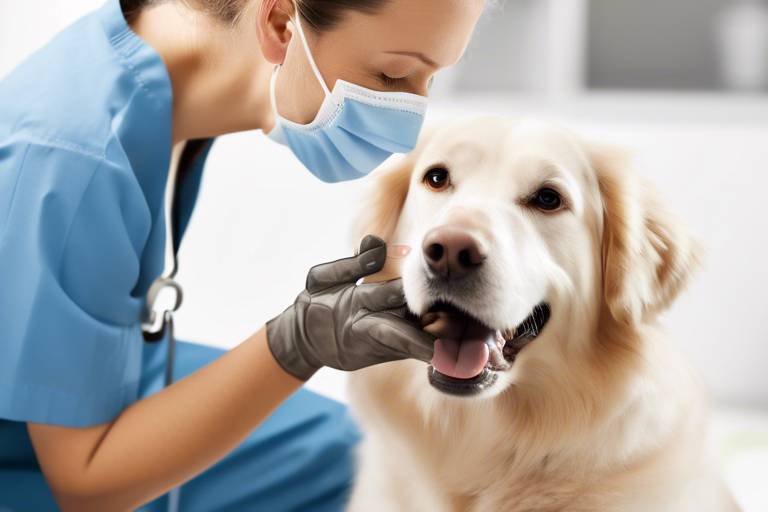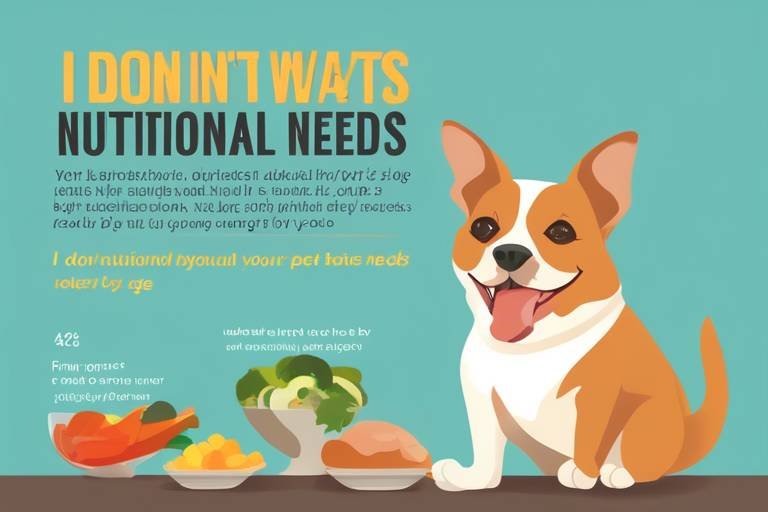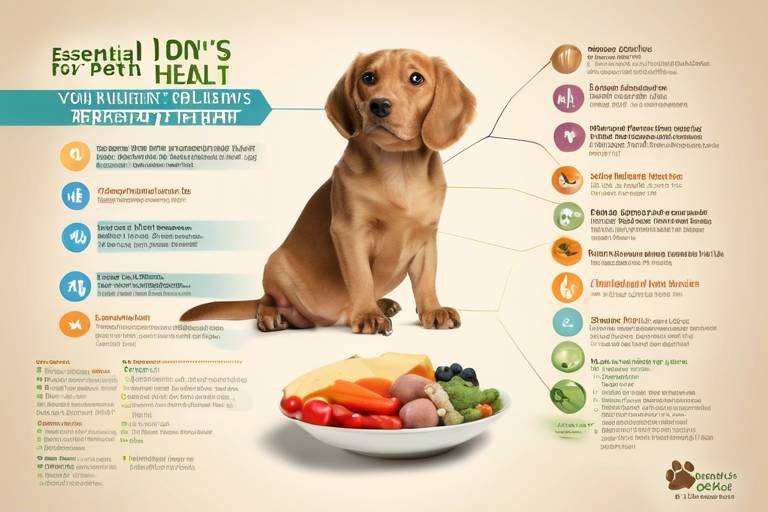Choosing the Right Diet for Your Pet
When it comes to our furry companions, choosing the right diet can feel like navigating a maze. With so many options available, how do you know what’s best for your pet? Just like us, pets have specific nutritional needs that change with their age, health, and lifestyle. It's essential to consider these factors to ensure your pet leads a healthy and happy life. Think of it as a puzzle where each piece represents a different aspect of your pet’s diet, and when put together correctly, it creates a picture of health and vitality.
Every pet is unique, with individual nutritional requirements based on their species, age, and health status. For instance, a sprightly puppy has different needs than a senior dog, just as a kitten's diet differs from that of an adult cat. Understanding these needs is crucial for selecting an appropriate diet that supports their overall well-being. Just imagine trying to fuel a sports car with regular gasoline—it simply won’t perform at its best! Similarly, your pet needs the right fuel to thrive.
When it comes to pet diets, the choices can be overwhelming. From dry kibble to wet canned food, raw diets to homemade meals, each type has its own set of advantages and disadvantages. It's important to evaluate what works best for your lifestyle and your pet's needs. For example, dry kibble is convenient and helps maintain dental health, while wet food can be more palatable and hydrating. However, if you're considering a raw or homemade diet, it requires careful planning to ensure all nutritional needs are met. Here’s a quick overview of the common types of pet diets:
| Diet Type | Advantages | Disadvantages |
|---|---|---|
| Dry Kibble | Affordable, convenient, helps dental health | May lack moisture, can be less palatable |
| Wet Canned Food | Higher moisture, more palatable | More expensive, less convenient for storage |
| Raw Diet | Control over ingredients, potential health benefits | Requires careful planning, risk of bacteria |
| Homemade Diet | Customization to pet’s needs | Time-consuming, requires nutritional knowledge |
Just like humans, some pets may have specific dietary requirements due to health conditions or allergies. Understanding these needs is essential for selecting the right food to support their health. For example, pets with food allergies may require specialized diets that eliminate common allergens. It’s like finding the right key to unlock a door—once you identify the problem, you can find the perfect solution.
Identifying food allergies or sensitivities is crucial for your pet's health. Symptoms can include itching, gastrointestinal upset, or even behavioral changes. If you suspect your pet has an allergy, consult your veterinarian to explore specialized diets that can help manage these conditions. Think of it as a detective story—gathering clues to solve the mystery of your pet’s discomfort!
As pets age, their nutritional needs change significantly. Providing age-appropriate diets ensures that they receive the right balance of nutrients to support their health at different life stages. Puppies and kittens need diets rich in protein and calories to fuel their growth, while senior pets may benefit from diets lower in calories but high in fiber to aid digestion. It’s like adjusting the thermostat in your home—what worked yesterday may not be suitable today!
- What is the best diet for my pet? The best diet depends on your pet's age, health, and lifestyle. Consult your veterinarian for personalized recommendations.
- Can I mix different types of pet food? Mixing different types of food can be done, but it’s important to ensure that the overall diet remains balanced. Gradual transitions are key!
- How do I know if my pet is allergic to certain foods? Look for signs like itching, digestive upset, or changes in behavior. A vet can help diagnose food allergies through testing.

Understanding Nutritional Needs
Every pet is unique, much like each of us has different tastes and preferences. This uniqueness extends to their nutritional requirements, which are influenced by a variety of factors including their species, age, activity level, and any existing health conditions. As a responsible pet owner, it’s essential to understand these needs in order to select the most suitable diet that promotes a long and healthy life for your furry friend.
For instance, puppies and kittens have different nutritional needs compared to adult or senior pets. They require a diet rich in calories and nutrients to support their rapid growth and development. On the other hand, senior pets often need diets that are lower in calories but higher in specific nutrients to maintain their health as they age. It’s like how we adjust our diets as we move through different stages of life—what works for a toddler won’t necessarily be the best for a teenager or an elderly person.
Moreover, pets that are more active, like working dogs or playful cats, may require a diet that provides higher energy levels. In contrast, pets that lead a more sedentary lifestyle may benefit from a diet that helps maintain a healthy weight. This brings us to the importance of understanding the balance of nutrients in your pet's food. A good pet diet should include:
- Proteins - Essential for growth, maintenance, and repair of tissues.
- Fats - A source of energy and necessary for healthy skin and coat.
- Carbohydrates - Provide energy and aid in digestion.
- Vitamins and Minerals - Crucial for various bodily functions and overall health.
Understanding these components is like being a chef who knows the perfect recipe. Each ingredient plays a crucial role in the final dish. If one ingredient is missing or not balanced correctly, the dish (or in this case, your pet's health) may suffer. Therefore, it's important to read labels, consult with veterinarians, and possibly even consider veterinary nutritionists when deciding on your pet's diet.
Lastly, it's vital to keep an eye on your pet's response to their diet. Are they energetic and playful? Is their coat shiny and healthy? Do they have a healthy weight? These are all indicators of whether their nutritional needs are being met. Regular vet check-ups can also help you monitor their health and make any necessary adjustments to their diet over time.

Types of Pet Diets
When it comes to feeding our furry friends, the choices can be overwhelming. With a myriad of options available, how do you choose the right diet for your pet? Each type of diet has its own set of benefits and drawbacks, making it essential to understand the different categories. Let's peel back the layers and explore the most common types of pet diets available today.
One of the most prevalent options is commercial pet food. These foods are specifically formulated to meet the nutritional needs of pets. They come in various forms, such as dry kibble, wet canned food, and even semi-moist options. The convenience of commercial pet foods is undeniable; they are readily available and often come with a balanced nutritional profile designed by experts. However, not all commercial foods are created equal. It's important to read labels and choose brands that prioritize quality ingredients.
Let’s dive deeper into the world of commercial pet foods. They are typically divided into two main categories: dry food and wet food. Each has its own unique characteristics that can cater to different pet needs. For instance, dry kibble is a popular choice among pet owners due to its affordability and shelf stability. It’s like the trusty old friend that’s always there when you need it! Plus, dry kibble can help maintain dental health by reducing plaque buildup.
Dry kibble is often the go-to option for many pet owners. It’s easy to store, doesn’t spoil quickly, and can be more economical than other types of food. However, one downside is that it generally lacks moisture. This can be a concern, especially for pets that don’t drink enough water. Think of it like eating a sandwich without a drink—it can be filling, but it might leave you feeling parched!
On the other hand, wet canned food tends to be richer in moisture content, making it a great choice for pets who need extra hydration. It’s often more palatable, which means picky eaters might be more inclined to chow down. However, it can be pricier and less convenient for long-term storage compared to dry kibble. If you’ve ever tried to store an open can of food in the fridge, you know it can get a bit messy!
For those who prefer a more hands-on approach, raw and homemade diets are gaining popularity. These diets allow pet owners to take control of what goes into their pet’s food, ensuring that only the freshest ingredients are used. However, it’s crucial to plan these diets carefully. Just like cooking for yourself, you need to ensure that you’re meeting all the nutritional needs of your pet. A poorly balanced homemade diet can lead to health issues, which is the last thing any pet owner wants!
In summary, the type of diet you choose for your pet can significantly impact their health and happiness. Whether you opt for the convenience of commercial foods or the control of raw and homemade diets, understanding the pros and cons of each option is vital. It's like picking the right outfit for a special occasion; you want something that fits well and makes you feel good. The same goes for your pet's diet—make sure it suits their individual needs!
Commercial Pet Foods
When it comes to feeding your furry friends, are often the go-to choice for many pet owners. These foods are specifically formulated to meet the nutritional standards set by various regulatory bodies, ensuring that your pet gets a balanced diet. With a plethora of options available, from dry kibble to wet canned food, the convenience and variety offered by commercial pet foods make them an attractive option. But what exactly makes these foods suitable for your pet?
One of the significant advantages of commercial pet foods is their formulation. Manufacturers invest in research to create diets that not only meet the basic nutritional needs of pets but also cater to specific health requirements. For instance, you can find formulas designed for puppies, adult dogs, senior pets, and even those with special dietary needs. This means that no matter the age or health status of your pet, there’s likely a commercial food that fits their profile.
Commercial pet foods are available in various forms, including:
- Dry Kibble: A staple in many households, dry kibble is known for its affordability and long shelf life.
- Wet Canned Food: This option tends to be more palatable and provides extra moisture, which is great for hydration.
- Freeze-Dried and Dehydrated Foods: These are gaining popularity, offering convenience while retaining nutritional value.
However, it’s essential to read the labels carefully. Look for products that list high-quality ingredients at the top of the ingredient list. The first few ingredients should ideally be animal proteins (like chicken, beef, or fish), as these are vital for your pet's health. Avoid products that contain excessive fillers, artificial preservatives, or by-products, as these can detract from the nutritional quality of the food.
Another important aspect to consider is the life stage of your pet. Puppies and kittens have different nutritional needs compared to adult or senior pets. For example, puppies require higher protein and calorie content to support their rapid growth, while senior pets may benefit from diets lower in calories but enriched with joint-supporting nutrients. Always consult with your veterinarian to determine the best commercial food for your pet's specific needs.
In summary, commercial pet foods offer a convenient and balanced way to feed your pets. They are formulated to meet the diverse nutritional needs of animals at various life stages and can be a practical choice for busy pet owners. However, being a savvy consumer means doing your homework—reading labels, understanding your pet's specific dietary needs, and consulting with a vet to ensure that you're providing the best possible nutrition for your beloved companion.
As you navigate the aisles of pet food options, remember: the right choice can lead to a healthier, happier life for your furry friend. So, take the time to explore the options and make an informed decision!
Q: How do I choose the right commercial food for my pet?
A: Start by considering your pet's age, weight, and any specific health concerns. Look for high-quality ingredients and consult your veterinarian for personalized recommendations.
Q: Are all commercial pet foods the same?
A: No, commercial pet foods vary widely in quality. Always check the ingredient list and choose a brand that meets the nutritional needs of your pet.
Q: Can I mix wet and dry food?
A: Yes, many pet owners choose to mix wet and dry food to provide variety and encourage hydration. Just ensure that the total daily intake meets your pet's nutritional needs.
Dry Kibble
When it comes to feeding your furry friend, often stands out as a popular choice among pet owners. Why is that, you might ask? Well, for starters, dry kibble is not only affordable but also incredibly convenient. Imagine being able to scoop out a portion of food, pour it into a bowl, and watch your pet dive in with enthusiasm! It’s like a fast-food meal for your pet, minus the drive-thru. Plus, the crunchy texture of kibble can help maintain your pet's dental health by reducing plaque and tartar buildup.
However, while dry kibble has its perks, it’s essential to consider some of its limitations. One significant drawback is its moisture content. Unlike wet food, which can be packed with hydration, dry kibble typically contains only about 10% moisture. This can be a concern, especially for pets that don’t drink enough water. Think of it like eating a cracker without anything to wash it down—dry kibble can sometimes leave your pet feeling parched.
Another important factor to consider is the variety available in the market. With countless brands and formulations, it can be overwhelming to choose the right kibble for your pet. It’s crucial to look for products that meet the AAFCO (Association of American Feed Control Officials) standards, ensuring that the food is nutritionally complete and balanced. Here’s a quick comparison of some popular dry kibble options:
| Brand | Protein Content | Price Range | Special Features |
|---|---|---|---|
| Brand A | 25% | $30-$50 | Grain-free, high protein |
| Brand B | 20% | $20-$40 | Veterinary recommended |
| Brand C | 30% | $40-$60 | Organic ingredients |
While dry kibble can be a great staple in your pet's diet, it’s important to balance it with other food types. Mixing in some wet food or incorporating fresh fruits and vegetables can provide additional moisture and nutrients. Remember, every pet is unique, and their dietary needs can vary based on factors like age, size, and activity level. So, always keep an eye on your pet’s health and consult with your veterinarian to ensure you’re making the best choices for their diet.
- Is dry kibble suitable for all pets? - While dry kibble is a popular choice, it may not be ideal for pets with specific health issues. Always consult your vet.
- Can I mix dry kibble with wet food? - Yes! Mixing both can provide a balanced diet and keep your pet interested in their meals.
- How much dry kibble should I feed my pet? - This depends on your pet's size, age, and activity level. Check the feeding guidelines on the kibble packaging and consult your vet for personalized advice.
Wet Canned Food
Wet canned food is often a favorite among pets, and for good reason! Not only does it come packed with moisture, which is essential for hydration, but it also tends to be more palatable for our furry companions. Imagine treating your pet to a gourmet meal that they can’t resist! The rich aroma and tender texture of wet food can make mealtime an exciting experience, transforming a mundane routine into a delightful occasion.
However, while wet canned food has its perks, there are some considerations that every pet owner should keep in mind. For starters, it can be more expensive than dry kibble, which might make it less appealing for those on a budget. Additionally, wet food often comes in cans that can be less convenient for long-term storage. Once opened, a can of wet food needs to be refrigerated and consumed relatively quickly to avoid spoilage.
To help you better understand the pros and cons of wet canned food, here’s a quick comparison:
| Advantages | Disadvantages |
|---|---|
|
|
When choosing wet canned food, it’s essential to read the labels carefully. Look for products that list high-quality proteins as the first ingredient, and be wary of fillers and artificial additives. A well-balanced wet food should provide all the necessary nutrients your pet needs to thrive.
In conclusion, wet canned food can be a fantastic addition to your pet's diet, offering a tasty and hydrating option. Just be sure to weigh the pros and cons and consider your pet's unique needs and preferences. After all, a happy pet leads to a happy home!
1. Is wet canned food better than dry food?
While both have their advantages, wet canned food is higher in moisture and often more palatable, making it a great option for hydration and picky eaters. However, dry food can be more economical and convenient for storage.
2. How do I transition my pet to wet canned food?
Introduce wet canned food gradually by mixing it with your pet's current food. Start with a small amount and slowly increase the portion of wet food over several days to avoid digestive upset.
3. Can wet canned food be fed exclusively?
Yes, but it’s essential to ensure that the wet food is nutritionally balanced. Consult your veterinarian to determine the best feeding strategy for your pet's specific needs.
Raw and Homemade Diets
When it comes to feeding our beloved pets, the idea of has gained considerable traction among pet owners. These diets allow you to take the reins on your pet's nutrition, providing a level of control that commercial foods may not offer. Imagine being able to hand-pick every ingredient that goes into your furry friend’s bowl—sounds appealing, right? However, while the concept is enticing, it comes with its own set of challenges.
One of the biggest advantages of a raw or homemade diet is the potential for quality control. You can choose fresh, whole ingredients, ensuring that your pet is getting the best possible nutrition. This can be particularly beneficial for pets with specific health issues or dietary restrictions. For instance, a homemade diet can be tailored to avoid allergens or to include ingredients that support your pet’s health, like omega-3 fatty acids for a shiny coat.
Nevertheless, crafting a balanced diet at home is not as simple as it may seem. Pets require a variety of nutrients, including proteins, fats, vitamins, and minerals, in precise ratios. A poorly balanced homemade diet can lead to nutritional deficiencies or excesses, which might cause health issues over time. Therefore, it's crucial to do your homework or consult with a veterinarian or a pet nutritionist to create a well-rounded meal plan that meets all of your pet’s dietary needs.
For those considering a raw diet, it’s essential to understand the risks and benefits. Raw diets often include uncooked meats, organs, and bones, which some pet owners believe mirror a pet's natural ancestral diet. However, these diets can also pose risks such as bacterial contamination and imbalanced nutrition if not properly managed. It’s vital to source high-quality ingredients and follow safe food handling practices to minimize these risks.
Here’s a quick overview of some common considerations when opting for raw and homemade diets:
| Consideration | Details |
|---|---|
| Ingredient Quality | Use fresh, high-quality ingredients to ensure optimal nutrition. |
| Balance | Ensure that the diet includes all necessary nutrients in appropriate proportions. |
| Health Risks | Be aware of potential risks like bacterial contamination and nutritional imbalances. |
| Consultation | Consult with a veterinarian or pet nutritionist for tailored advice. |
In summary, while raw and homemade diets can offer a customized approach to your pet's nutrition, they require diligent planning and knowledge. If you’re ready to take the plunge, make sure to arm yourself with information and professional guidance. After all, nothing is more rewarding than seeing your pet thrive on a diet that you’ve carefully crafted just for them!
- What are the benefits of feeding my pet a raw diet? Raw diets can offer higher quality ingredients and allow for tailored nutrition to meet your pet's specific health needs.
- Are there risks associated with homemade diets? Yes, homemade diets can lead to nutritional imbalances if not properly formulated, and raw diets may pose health risks from bacteria.
- How can I ensure my homemade diet is balanced? Consult with a veterinarian or pet nutritionist to create a balanced meal plan that meets all of your pet's nutritional needs.
- What ingredients should I avoid in homemade pet diets? Avoid ingredients that are toxic to pets, such as onions, garlic, chocolate, and certain artificial additives.

Special Dietary Considerations
When it comes to our beloved pets, one size definitely does not fit all. Just like humans, pets have their own unique dietary needs that can vary based on factors such as age, health conditions, and even breed. Understanding these special dietary considerations is essential for ensuring that your furry friend stays healthy and happy.
For instance, pets with specific health issues, such as diabetes or kidney disease, often require specialized diets. These diets are designed to manage their conditions effectively and promote overall wellness. It’s crucial to consult with a veterinarian to tailor a diet that meets your pet’s individual needs. Think of it as crafting a personal nutrition plan, just like you would for yourself if you were managing a health condition.
Moreover, food allergies and sensitivities are becoming increasingly common in pets. Identifying these issues can be a bit like solving a mystery. You might notice your pet scratching more than usual, experiencing gastrointestinal upset, or showing signs of lethargy. If you suspect your pet has a food allergy, it’s vital to work with your vet to conduct an elimination diet. This process involves removing certain foods from their diet and then gradually reintroducing them to pinpoint the culprit.
Another important factor to consider is the age of your pet. Just as children and adults have different nutritional needs, so do pets at various life stages. Puppies and kittens, for example, require diets rich in protein and calories to support their rapid growth and development. On the other hand, senior pets may benefit from diets lower in calories but higher in fiber to aid digestion and maintain a healthy weight. Providing age-appropriate diets ensures that your pet gets the right balance of nutrients throughout their life.
| Age Group | Nutritional Needs |
|---|---|
| Puppies/Kittens | High protein and calories for growth |
| Adult Pets | Balanced diet for maintenance |
| Senior Pets | Lower calories, higher fiber for digestion |
In conclusion, paying attention to these special dietary considerations can make a world of difference in your pet's life. By understanding their unique needs, you can provide a diet that not only supports their health but also enhances their quality of life. After all, a happy pet is a healthy pet!
- What are the signs my pet might have a food allergy? Look for symptoms like excessive scratching, gastrointestinal issues, or sudden changes in behavior.
- How do I choose the right food for my pet? Consult with your veterinarian to understand your pet's specific nutritional needs and consider their age, health conditions, and preferences.
- Can I switch my pet's diet suddenly? It's best to transition gradually to avoid digestive upset. Mix the new food with the old food over several days.
- Are homemade diets safe for pets? Homemade diets can be safe if properly balanced, but it's crucial to consult with a vet to ensure all nutritional needs are met.
Allergies and Food Sensitivities
When it comes to our furry companions, their health and happiness are top priorities. One of the most common issues pet owners face is dealing with . Just like humans, pets can experience adverse reactions to certain ingredients in their food, which can lead to discomfort and health problems. It's essential to recognize the signs of food allergies, as they can significantly impact your pet's quality of life.
So, how do you know if your pet is suffering from a food allergy? Common symptoms include:
- Itchy skin or excessive scratching
- Digestive issues like vomiting or diarrhea
- Ear infections that seem to persist
- Unusual behavior, such as lethargy or irritability
If you notice any of these signs, it's crucial to consult your veterinarian. They can help determine if your pet has a food allergy and guide you through the process of identifying the offending ingredient. This often involves an elimination diet, where you introduce new foods one at a time to pinpoint the allergen.
In many cases, the most common allergens for pets include:
- Beef
- Dairy products
- Chicken
- Wheat
- Fish
Once you've identified the allergen, you can choose a specialized diet that avoids these ingredients. There are numerous hypoallergenic pet foods available on the market, specifically designed to cater to pets with food sensitivities. These foods often contain novel proteins or are hydrolyzed, meaning the proteins are broken down into smaller, less allergenic components.
Furthermore, it's important to remember that food sensitivities can change over time. A pet that once thrived on a particular diet may develop sensitivities later in life. Regularly monitoring your pet's health and being observant of any changes can help you stay ahead of potential issues.
In summary, being aware of your pet's dietary needs is essential for their overall well-being. By understanding the signs of allergies and food sensitivities, you can take proactive steps to ensure that your furry friend enjoys a healthy, happy life. Remember, consultation with a veterinarian is key in managing these conditions effectively.
- What are the common signs of food allergies in pets?
Common signs include itchy skin, digestive upset, ear infections, and changes in behavior. - How can I identify what my pet is allergic to?
The best way is to conduct an elimination diet under veterinary supervision. - Are hypoallergenic diets effective for all pets?
Hypoallergenic diets can be effective, but it’s essential to consult with a vet to ensure it meets your pet’s specific needs. - Can food sensitivities develop later in life?
Yes, pets can develop sensitivities at any age, so it's important to monitor their health regularly.
Age-Appropriate Diets
As our beloved pets grow older, their nutritional needs evolve significantly. Just like humans, pets experience different life stages that require tailored diets to maintain their health and vitality. For instance, a puppy has different dietary requirements than a senior dog. Understanding these differences is essential for pet owners who want to provide the best care possible.
In the early stages of life, puppies and kittens need a diet rich in proteins and fats to support their rapid growth and development. This is akin to how children need a balanced diet full of nutrients to fuel their growth spurts. High-quality commercial pet foods designed for young animals often contain the right balance of vitamins and minerals necessary for their development. On the other hand, as pets mature, their metabolism slows down, and their dietary needs shift. Senior pets typically benefit from diets that are lower in calories but higher in fiber to help manage weight and promote healthy digestion.
Moreover, age-appropriate diets can help prevent common health issues that arise as pets age. For example, older pets may be more prone to joint problems and require diets enriched with omega-3 fatty acids to support joint health. Similarly, senior pets might face dental issues, making softer food options more suitable for their comfort. It's essential to look for food specifically formulated for senior pets, as these often contain modified levels of protein and fat tailored to their changing needs.
When choosing an age-appropriate diet, consider the following factors:
- Life Stage: Ensure the food is specifically formulated for your pet's current life stage, whether it be puppy, adult, or senior.
- Health Conditions: If your pet has specific health concerns, consult your veterinarian for recommendations on suitable diets that cater to those issues.
- Ingredient Quality: Look for high-quality ingredients that provide the necessary nutrients without fillers or artificial additives.
In summary, selecting the right diet based on your pet's age is crucial for their overall well-being. Regular veterinary check-ups can help monitor their health and adjust their diet as necessary. Remember, a well-nourished pet is a happy pet!
1. How often should I change my pet's diet as they age?
It's best to transition to a new diet gradually, usually when your pet reaches their senior years or if they have specific health concerns. Consult with your veterinarian for personalized advice.
2. Can I mix different types of food for my pet?
Yes, but it's essential to ensure that the combination meets all of your pet's nutritional needs. Mixing wet and dry food can provide variety and help with hydration.
3. What should I do if my pet refuses to eat their age-appropriate food?
If your pet is refusing to eat, it may be worth trying different brands or flavors. However, if this persists, consult your veterinarian to rule out any underlying health issues.
Frequently Asked Questions
- What should I consider when choosing a diet for my pet?
When selecting a diet for your furry friend, consider their species, age, health status, and any specific dietary needs they may have. It's essential to understand their unique nutritional requirements to ensure they lead a healthy and happy life.
- Are commercial pet foods safe and nutritious?
Yes, commercial pet foods are formulated to meet specific nutritional standards. They are generally safe and can provide balanced nutrition for your pet. However, it's important to choose high-quality brands and check the ingredient list for any fillers or harmful additives.
- What are the benefits of dry kibble versus wet canned food?
Dry kibble is typically more affordable, convenient, and helps maintain dental health due to its crunchy texture. On the other hand, wet canned food often contains higher moisture content, making it more palatable for pets. However, it can be pricier and less convenient for storage.
- Can I feed my pet a raw or homemade diet?
Absolutely! Raw and homemade diets can be nutritious and allow you to control your pet's ingredients. However, careful planning is crucial to ensure these diets meet all of your pet's dietary needs, so consulting with a veterinarian is highly recommended.
- How can I identify food allergies in my pet?
Identifying food allergies involves observing your pet's reactions to certain foods. Symptoms may include itching, gastrointestinal issues, or unusual behavior. If you suspect allergies, consult your veterinarian for guidance on specialized diets and allergy testing.
- Do pets have different nutritional needs as they age?
Yes, as pets age, their nutritional requirements change. Older pets may need diets lower in calories but higher in fiber, along with specific nutrients to support joint health and overall well-being. It's crucial to provide age-appropriate diets to meet these evolving needs.
- How do I know if I'm feeding my pet the right amount?
The right amount of food for your pet depends on their size, age, activity level, and diet type. Most commercial pet foods provide feeding guidelines on the packaging. Regularly monitoring your pet's weight and body condition can help you adjust portions as needed.



















